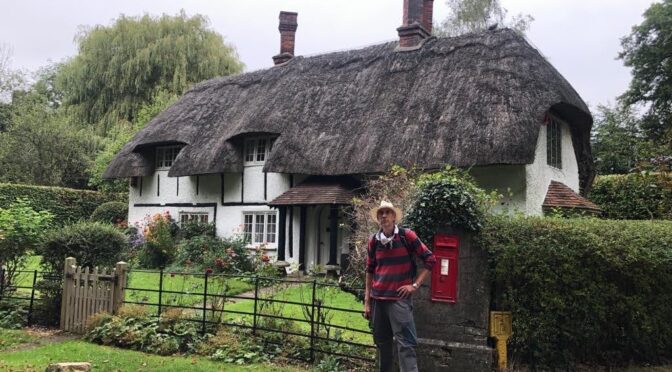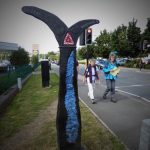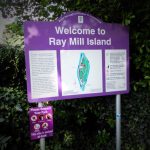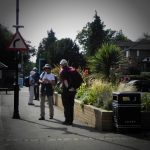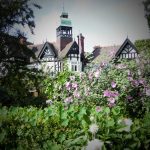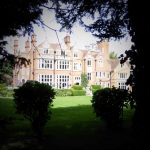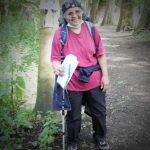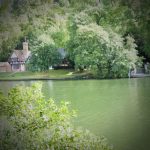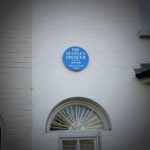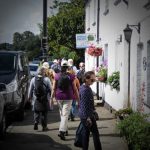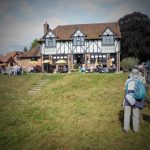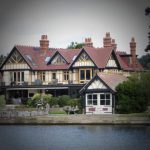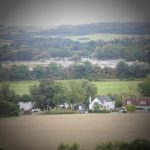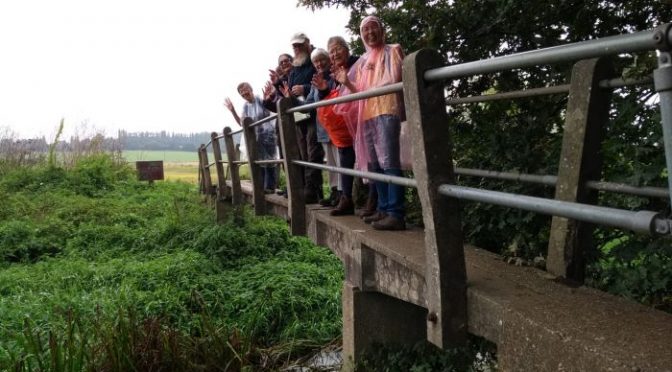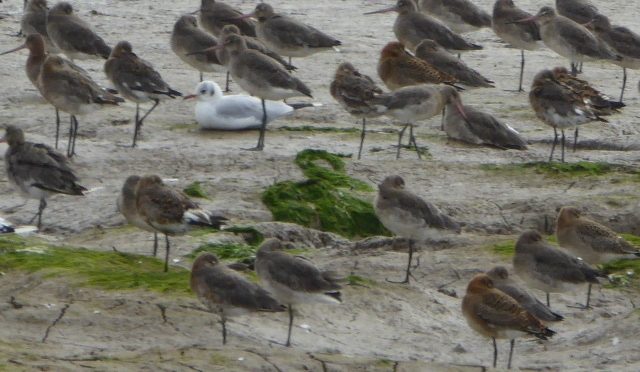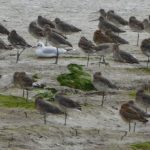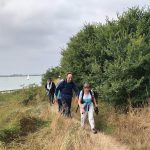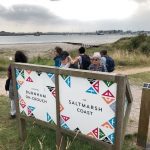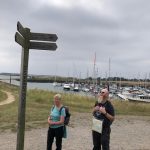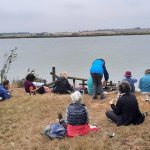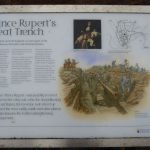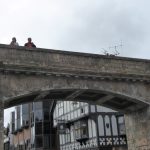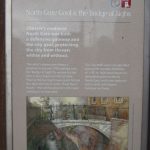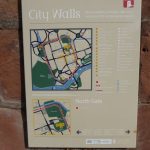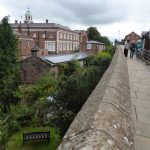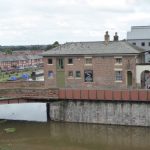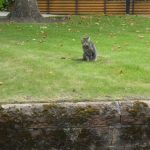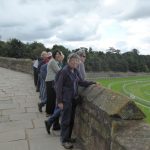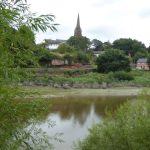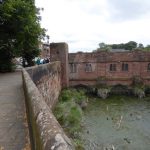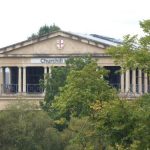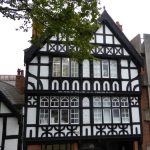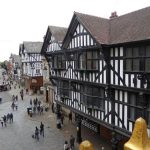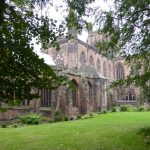Fifteen walkers and Teddy (the dog) gathered in the Chiltern market town of Princes Risborough on a grey but warm and humid Saturday. Princes Risborough has medieval origins and my guidebook told me that the under the car park we were standing in was the foundations of the 14th century manor house of Edward the Black Prince. Disappointingly the group didn’t seem that impressed by this fact. The first park of the walk took us south through meadows to the hamlets of Horsenden and Saunderton. We diverted to look at the 15th century churchyard in Horsenden. Continue reading PRINCES RISBOROUGH CIRCULAR – 25 SEPTEMBER
All posts by Gillian
Maidenhead to Marlow. Saturday 11 September.
Eighteen Poly Ramblers met at Maidenhead station and made their way to the River Thames by Brunel’s famous rail bridge. It is the widest brick arch ever built and features in Turner’s 1844 painting ‘Rail, Steam and Speed’ viewed by Mick and Dolly just a few days earlier in the National Gallery.
We then followed the Thames Path to Cookham passing Boulter’s Lock described in Jerome K. Jerome’s 1889 novel Three Men in a Boat and the Cliveden Estate centre of the notorious Profumo scandal of 1963.
Six members ended their walk in Cookham whilst the rest of us, after a picnic lunch and a swift drink in the Crown pub’, rejoined the riverbank before heading inland and up a short but steep and narrow path onto an escarpment. We were rewarded with fine views of the Thames Valley as we followed the contour of the hill to its peak at Winter Hill before descending into the pretty eighteenth century town of Marlow.
Missing the hourly train, known as the Marlow Donkey, back to Maidenhead, necessitated us enjoying a drink in the sunny garden of the Marlow Donkey pub’ before heading home.
Jennifer and Sunita with photos by Stuart
Debden Lambourne Theydon Bois – 19 September
Danny having been incapacitated by a leg injury, I volunteered to stand in for him to lead this walk. I went on a walkover the Sunday before. Just as well. There were places on the walk description (printed in 1994) that were rather elliptical not to say misleading, starting with inclusion of the word “stroll”! It all went fairly smoothly at the beginning. I stopped in the village of Abridge for a lime and soda and chat to a customer about local history, discovering that the spirit of Dick Turpin is alive and kicking! The description matched the reality, despite the occasional lack of waymarkers or other signposts, or overgrown brambles, until I was misdirected through a very overgrown series of field margins in search of a footbridge over the so-called River Roding (which at that point was more like a wide watery ditch). The worst was a field of waist-high thistles, nettles and brambles which I got out of with difficulty. It was all so undesirable that I couldn’t put my prospective group through the same sequence of obstacles, so I did a second walkover with Harriet. We found the intended footbridge over the River Roding and pruned brambles with our secateurs where necessary. We were impressed by the distant spotlit view of the City of London from the brow of Theydon Bois Wood (Theydon Wood Wood?). Continue reading Debden Lambourne Theydon Bois – 19 September
NORTH FAMBRIDGE TO BURNHAM ON CROUCH – 4 SEPTEMBER
Eleven polys arrived at Fambridge North on the Dengie Peninsula on a rather grey but mild morning. We soon arrived at the sea wall on the River Crouch. We walked along the meandering river with its several creeks, remarking on the tranquillity of our surroundings and the beautiful views on both sides. Being tidal, the river attracts various wading birds. We were a little too early in the year for those which winter in the area but we did see some geese in flight. It was quite windy at times, so we were pleased to find a sheltered spot just before Creeksea for our picnic. The clouds finally cleared and the sun came out as we continued into Burnham on Sea, walking through the large marina and onto the quay. We spotted some birds on the mud flat but could not identify them. Later Pam informed me that she could ‘confirm that we saw a pied wagtail (grey and white) hopping around and wagging his tail on the seaweed on the rocks and my contacts have confirmed that the flock of birds we saw sitting on the mud as we approached Burnham on Crouch definitely look like black-tailed godwits – see photo. The white bird with the black dot on his ear in the middle of the flock is a black-headed gull in winter plumage.’ At least the wagtail wags his tail! We enjoyed tea, cake and ice cream sitting overlooking the estuary. As we returned to London we agreed that it had been a very pleasant relaxing walk, perfect after the exertions undertaken by those who had attended the Chester weekend.
Susan. Photos by Ida, Susan and Pam
CHESTER TRIP – TUESDAY. CITY WALLS WALK
We gathered at the Northgate to walk the almost 2 mile circuit, the most complete town walls in Britain. After the Civil War they were no longer required to be fortified for defence and were developed as a recreational walkway. We walked anti-clockwise and the first section gave us a good view of the racecourse. This is the oldest one in the country, dating back to 1539. It is on the site of the port of Chester which was bustling in Roman times but the River Dee had silted up here by the 1500s and changed its course. We were able to observe many of the various buildings we had seen on Friday from a different perspective. The view of the cathedral was particularly impressive and the famous Eastgate clock celebrating Queen Victoria’s Diamond Jubilee proved popular for photos. One section of the walls near Eastgate collapsed in 2008 and repairs are ongoing. Various panels showed us the timeline of the repairs and how these have been carried out. On our return to Northgate we dispersed, some to collect their luggage and make their way to the station to return to London, others to spend a little more time in this fascinating city steeped in history before heading home.
Susan. Photos by Stuart

